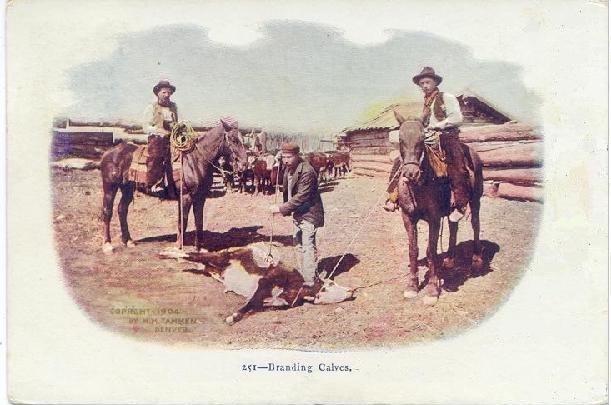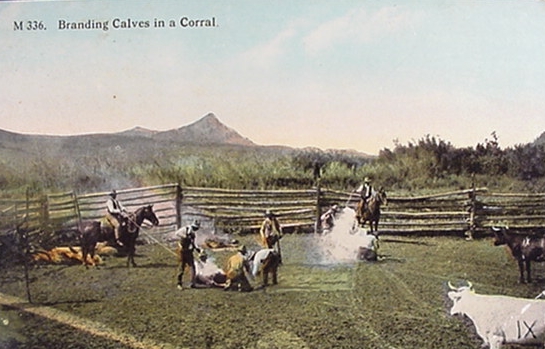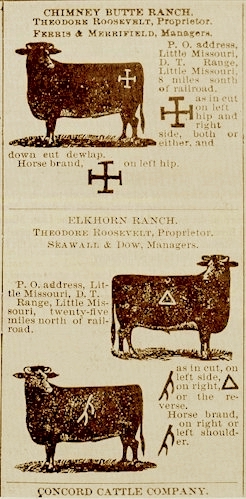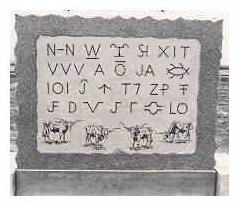
Branding, 1904, published by H. H. Tammen
For discussion of Harry Heye Tammen, see Cody. Branding in a corral involved first roping the calf, in some instances the corral would have
a snubbing post to which the calf would be tied while stretched with a rope so the iron
could be applied. Following the branding the calf would be "marked;" i. e. turned into a steer, and incidently
producing Rocky Mountain oysters.

Branding in a Corral, 1909
The practice of branding has been traced back to ancient Egypt. It was brought to
North America by the Spanish. In Mexico brands could be quite elaborate. In the
United States brands are composed of letters, squares, diamonds, slashes, bars, and other symbols, all in different
compositions and placements.
 Open A Long X Long X
 Running W Running W Lazy J Lazy J
Thus, the letter A, as an example, may be in the
ordinary form or as an "Open A" without the cross bar, or the letter might be stretched as in the
example of the "Long X" above. The letter might also be put into a "running" configuration, as in the
King Ranch's Running W above. Letters might be "lazy," that is, turned on their side or drooping, as for example a
Lazy J, illustrated above, or a Lazy M, see below. Brands are read left to right, top to bottom, or
outside in. Thus, both of the following brands are read as a Lazy M Bar, and the "Circle R" below is always
read as a Circle R and never as an R Circle

Business Card, Theodore Roosevelt's Concord Cattle Company, illustrating Roosevelt's
"Maltese Cross" and "Elk Horn" brands.
 Lazy Em Bar Lazy Em Bar
 Lazy Em Bar Lazy Em Bar
 Circle R Circle R
 Flying P Flying P
Cowboys might be a little irreverent about the brands. Thus, the second Lazy Em Bar was sometime
referred to as the "Buzzard on a Rail." See also the "Turkey Track" below.
 Rafter J Rafter Eleven Rafter ElevenOne might begin to "decorate" the
letters or numbers. By adding a roof to the letter J, we get the Rafter J, or by adding the roof to
the number eleven, we get one of Addison Spaugh's brands, the Rafter 11. See also the Rafter I below. One
might add one or two "wings" to a letter, as in the example of the "Flying P" above, or the "Flying O" below, or the "Flying
V" toward the bottom of the page. By the addition of a quarter circle to the bottom of a letter is is referred to as "rocking,"
as in the famous "Rocking R" below.
 Flying O  The Hashknife The Hashknife
 Rocking R Rocking R Quarter Circle R Quarter Circle R
Other variations can be made. A letter with legs is referred to as "walking." A letter which
is tilted is "tumbling." Pictographs can also be used such as the "Bug," discussed below, Theodore Roosevelt's Elk Horn,
or the Hashknife above.
 N Bar N
 H Bar Open A H Bar Open A Lazy J Hanging T Lazy J Hanging T
Although, many brands are left to right as in the case of the N Bar N and the H Bar Open A, above, other
configurations are possible such a hanging a letter off of another as in the instance of the
Lazy J Hanging T above. As a result, literally thousands of combinations are
possible, thus, requiring Brand Books, such as depicted to the right.

Wyoming Brand Book
The early Spanish introduced cattle into Mexico. By 1537 it became necessary to establish a central registry in Mexico City in which all brands
were to be listed. The practice of branding and the practice of registering the brands followed the Spanish into Texas.
In the English Colonies cattle were identified by ear marks. Thus, on Long Island, registrations of
ear marks are to be found as early as 1707. In upstate New York in the Town of New Windsor, various
ear marks were recorded by Thomas Woodhull, Joseph Wilken, Thurston Wood, and Henry Still. Thus, Wilken's mark, recorded
on May 15, 1807, for
cattle was noted as "a slit in the left ear and a half penny on the
underside of the right ear."
In Wyoming, orignally brands and ear marks were recorded in each county, but at
an early point, registration was required to be at the State level. According to Russell Thorp, one of the
first brands in the Territory was an "Open 9," maybe similar to the following,
 Registrations are
required to be renewed in years ending in 5, i. e. 1995, 2005, etc. With approximately 28,000 brands
in Wyoming books showing the various brands are a necessity. Brand Books
are issued every ten years with periodic supplements. The books show first, a picture of the
brand, secondly, a diagram of any ear marks, and the name and address of the owner of the
brand. In some states, such as California and Nebraska, the brand book may be accessed on
the Internet.

Texas Trail Monument, Goshen County
First Row: "N Bar N," Wm. F. Niedringhaus and Frederick W. Niedringhaus, Panhandle City, Tex.;
W Bar, Pierre Wibaux, Wibaux Montana; "Hashknife,"
J. R. Couts and John N. Simpson, Abilene, Texas; "S H," Northern Cattle Company, Little Powder
River, Mont.; "X I T," Capitol Freehold and Investment Company.
Second Row: "Three V's," Western Ranches, Ltd, on the Belle Fource;
the "A;" the "Bar O," J. W. Sacra, E. C. Suggs and J. W. Suggs, Salt Fork of the
Red River; the "J A," Charles Goodnight, Palo Duro Canyon, Texas; the "Bug," Montana.
Third Row: "101," Standard Cattle Company, Moorcroft and Fallen County, Mt.; "Half Circle J," Clay County, Texas;"
"Turkey Track" (sometimes referred to as the "Rafter I"), Hansford Land and Cattle Company; "T 7," Campbell County, Wyo.; Unidentified; Unidentified.
Fourth Row: "J F, see photo lower right;" "D," P. F. Dunn, Corpus Christi, Tex.; "Flying V," Matador Land and Cattle Company, Ltd. (see text below),
Dundee, Scotland and Ballard Springs, Tex.; Unidentified; "Blocker 7,"
trail brand of John R. Blocker of Texas. (see text below); "Mill Iron," Texas and Montana;
"L O," Montana

Cow Puncher, J F Ranch, undated
[Writer's notes:
 The Hashknife, started in
Texas and had properties in Arizona and Montana. The "Hashknife Outfit" noted by Zane Grey was
owned by the Aztec Cattle Company in Arizona. A hashknife was an implement frequently
found on a chuckwagon. The Hashknife, started in
Texas and had properties in Arizona and Montana. The "Hashknife Outfit" noted by Zane Grey was
owned by the Aztec Cattle Company in Arizona. A hashknife was an implement frequently
found on a chuckwagon.
 The J A bears the initials of John Adair, Charles Goodnight's financial backer
in the J A. Goodnight also used a circle as a trail brand. While brands were typically placed on the hip, trail brands
were often placed on the left side. Additionally, brands might be placed on the jaw. Original brands, when the
animal was sold, might be vented (crossed off) and the new owner's brand placed nearby.
The animal would also bear various knife cuts on ears, wattles, and dewlaps, to assist in
identification. Thus, a brand book carried on a roundup would include notations both as to
brands, but locations and earmarks. The J A bears the initials of John Adair, Charles Goodnight's financial backer
in the J A. Goodnight also used a circle as a trail brand. While brands were typically placed on the hip, trail brands
were often placed on the left side. Additionally, brands might be placed on the jaw. Original brands, when the
animal was sold, might be vented (crossed off) and the new owner's brand placed nearby.
The animal would also bear various knife cuts on ears, wattles, and dewlaps, to assist in
identification. Thus, a brand book carried on a roundup would include notations both as to
brands, but locations and earmarks.
The X I T was formed when the old Texas State Capitol Building burned. The estimated cost of
one and half million dollars was raised by the sale of state lands in the Panhandle of Texas to a
the Texas Ranch Capital Syndicate, which in turn raised money in Britain from the
Capitol Freehold and Investment Company. With cost overruns the new capitol cost in excess of
$3,000,000. Ultimately, the Company had over 3,000,000 acres in
Texas and Montana. Over an 11 year period 12,500 cattle were trailed annually to Montana and
South Dakota. After 1900 the Company began to liquidate. The last of its cattle were
sold in 1912, but it took until 1963 to dispose of the last of its land holdings. Although it is
a popular old wives' tale that the brand stood for "Ten in Texas" as a result of the
ranch spreading over ten counties, it was probably designed for ease of application with a
running iron and difficulty of modification. It's brands were registered in five states. Thus, it was not necessary to
have a road brand.

XIT brands as registered in Montana, 1903.

Branding on the Open Range, approx. 1905
 The "Blocker 7," pictured to the left, was a "road brand"
used by John Rufus Blocker (1851-1927), a contract drover who, with his brother Abner "Ab" Pickens Blocker (1856-1943),
trailed cattle for a thirty-year period, 1873-1903, to Colorado, Dakota Territory, and Wyoming.
The Potter-Blocker Trail, from Albany, Texas to Cheyenne, is named after Jack Potter and Abner Blocker.
The trail was laid out by Potter after he was diverted from crossing Charles Goodnight's J A by the imposition
of the "Winchester Quarantine" by Goodnight. Abner is credited with the design of the X I T brand. The Blocker Brothers last
major drive was of 9,000 head to Deadwood, S. Dak. in 1893. The "Blocker 7," pictured to the left, was a "road brand"
used by John Rufus Blocker (1851-1927), a contract drover who, with his brother Abner "Ab" Pickens Blocker (1856-1943),
trailed cattle for a thirty-year period, 1873-1903, to Colorado, Dakota Territory, and Wyoming.
The Potter-Blocker Trail, from Albany, Texas to Cheyenne, is named after Jack Potter and Abner Blocker.
The trail was laid out by Potter after he was diverted from crossing Charles Goodnight's J A by the imposition
of the "Winchester Quarantine" by Goodnight. Abner is credited with the design of the X I T brand. The Blocker Brothers last
major drive was of 9,000 head to Deadwood, S. Dak. in 1893.
 Right: Swan Land and Cattle Company, Ltd. (the "Two Bar," see brand on left hip.) Brands, 1884
Right: Swan Land and Cattle Company, Ltd. (the "Two Bar," see brand on left hip.) Brands, 1884
Many stockgrowers would have multiple brands. The Two Bar had so many, the foremen actually had to
carry a brand book around with them to indentify the Company's own cattle. See Two Bar brands to the right.
The Three V's was owned by Western Ranches, Ltd., located on the Belle Fourche. Today, the
Company is noted as the ranch from whom the Sundance Kid stole a horse.
The 101 was a brand used by the Standard Cattle Company which had properties near Moorcroft and Custer County,
Montana as well as Nebraska. The brand was also used by Miller's Hundred and One, near Guthrie, Oklahoma.
 The Turkey Track, sometimes also referred to as the "Rafter I," was owned by the Hansford Land and
Cattle Company which acquired the brand in 1883. It was a Scottish-owned company with its headquarters at Number 3 India building, Dundee.
By 1890, the company owned some 85,000 acres and leased another 350,000 acres. At the time, it
had an average cattle count of 30,000 head. The Hansford Land and Cattle Company began to sell out
in 1900 and ceased operations in 1916. The brand is, however, still in use. The Turkey Track, sometimes also referred to as the "Rafter I," was owned by the Hansford Land and
Cattle Company which acquired the brand in 1883. It was a Scottish-owned company with its headquarters at Number 3 India building, Dundee.
By 1890, the company owned some 85,000 acres and leased another 350,000 acres. At the time, it
had an average cattle count of 30,000 head. The Hansford Land and Cattle Company began to sell out
in 1900 and ceased operations in 1916. The brand is, however, still in use.
 The Flying V was a brand used by the Matador, a British owned outfit, which had interests from
Texas to Saskatchewan, although the brand was usually made as shown to the left. The Flying V was also used by
ranches in Oklahoma, Kansas and Wyoming. Therefore, brand books would make distinctions based on the location
of the brand on the left, right, etc. Some brand books would also contain maps
showing the normal range for a particular brand. The Flying V was a brand used by the Matador, a British owned outfit, which had interests from
Texas to Saskatchewan, although the brand was usually made as shown to the left. The Flying V was also used by
ranches in Oklahoma, Kansas and Wyoming. Therefore, brand books would make distinctions based on the location
of the brand on the left, right, etc. Some brand books would also contain maps
showing the normal range for a particular brand.
 The Mill Iron was started in Texas and also had properties in Montana on the Box Elder in Carter County. Its last drive
to Montana was in 1894.] The Mill Iron was started in Texas and also had properties in Montana on the Box Elder in Carter County. Its last drive
to Montana was in 1894.]
Music this page:
THE LAST GREAT ROUNDUP
Last night as I lay on the prairie,
I gazed at the stars in the sky.
I wondered if ever a cowboy
Would land in that sweet by and by
They say there will be a great round-up,
Where cowboys like dogies will stand,
To be cut by the riders from heaven,
Who are noted and know every brand.
The road that leads down to perdition
Is narrow and dim so they say.
And the road that leads up to God's Kingdom,
Is staked out and blazed all the way.
I wonder if ever a cowboy,
Would prepare for that great judgment day,
Could say to the boss of the riders,
"I'm ready to be driven away."
They say we will never forsake you,
For He knows every action and look.
So for safety you 'd better be branded,
And have your name in the old valley book. |
Next page: Chugwater and the Swan Land and Cattle Company.
|